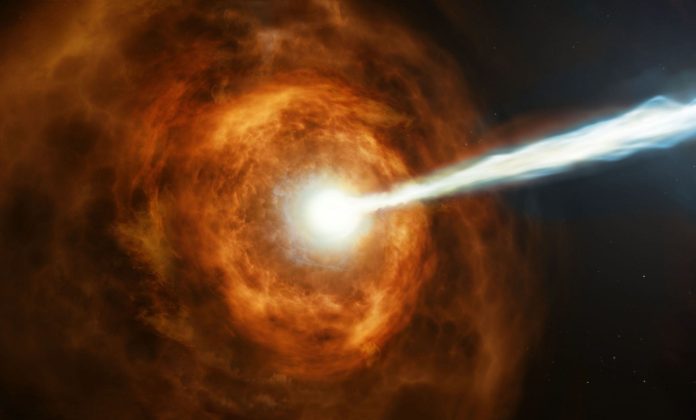
In October 2022, the Fermi Gamma-ray Space Telescope and the Neil Gehrels Swift Observatory detected an extraordinarily powerful Gamma Ray Burst (GRB).
It still stands as the Brightest Of All Time (BOAT), and astronomers have been curious about it ever since.
New research has uncovered more details in the burst. What do they tell us about these forceful explosions?
GRBs are the most powerful energetic events in the Universe, second only to the Big Bang. They’re brief yet powerful explosions that can release as much energy in a few seconds as the Sun will release in its billions of years of fusion.
Astronomers don’t completely understand the mechanism behind them.
They seem to come from the explosion of an extremely massive star or the merger of two extremely dense objects like neutron stars or black holes.
A GRB’s initial burst is called the prompt emission.
While the prompt emissions themselves last anywhere from milliseconds to several hundred seconds, GRBs have afterglows that are much longer-lived and emitted in wavelengths longer than gamma rays: X-ray, ultraviolet, optical, infrared, microwave, and radio emissions.
This means that astronomers can still study their source long after the gamma rays have disappeared.
When BOAT, aka GRB 221009A, was discovered, it was so powerful that it saturated Fermi’s detectors. That means astronomers weren’t able to observe some of the GRB’s most energetic moments.
In new research published in Science, astronomers say they’ve found another peak in GRB 221009A’s prompt emissions data. The research is “A mega–electron volt emission line in the spectrum of a gamma-ray burst.” The lead author is Maria Edvige Ravasio, a Post-doctoral Researcher in Astrophysics at Radboud University in Nijmegen, Netherlands. This peak is a new clue about what happens during a GRB.
“The physics of the prompt emission is poorly understood: The dominant form of energy in the relativistic jet is unknown, as is the nature of the radiative process responsible for producing the observed photons,” the authors write in their paper.
In their new research, the team used observations of the GRB and combined them with statistical models to identify new features. They divided the GRB into different time intervals and analyzed them separately and together. They focused on the parts of the prompt emission that weren’t the brightest. “We investigated the less bright portions of the prompt emission,” they write, and they avoided the portion of the signal that was saturated by the GRB’s extraordinary power.
“A few minutes after the BOAT erupted, Fermi’s Gamma-ray Burst Monitor recorded an unusual energy peak that caught our attention,” said Ravasio. “When I first saw that signal, it gave me goosebumps.
Our analysis since then shows it to be the first high-confidence emission line ever seen in 50 years of studying GRBs.” A high-confidence emission line is a specific wavelength of light that’s unlikely to be noise.
Like everything else about GRBs, the line was transient. It only lasted 40 seconds, but it’s still significant. It occurred about five minutes after the initial burst and peaked at 12 MeV (million electron volts). To put that into context, the light our eyes can sense, called visible light, ranges from only two to three eV.
The newfound emission line is significant because of what happens to the energy emitted by GRBs. When powerful electromagnetic radiation collides with matter, it can be absorbed and then re-emitted at lower wavelengths. Depending on conditions, some wavelengths of light will be more prominent than others.
Astronomers examine the light spectroscopically, and depending on the light that’s prominent or obscured, they can learn a lot about the chemistry of the matter that’s emitting the light. Some of the features in the spectrum can also reveal particle processes that are occurring. One of those processes is the annihilation of matter and anti-matter.
When astronomers studied the absorption and emission spectra from GRBs in the past, they couldn’t be certain that what they were seeing wasn’t noise. But this time, it’s different.
“While some previous studies have reported possible evidence for absorption and emission features in other GRBs, subsequent scrutiny revealed that all of these could just be statistical fluctuations.
What we see in the BOAT is different,” said coauthor Om Sharan Salafia at INAF-Brera Observatory in Milan, Italy. “We’ve determined that the odds this feature is just a noise fluctuation are less than one chance in half a billion.”
The researchers think that the emission line comes from gamma rays travelling at nearly the speed of light. Their most likely source is exotic: the annihilation of matter and anti-matter.
“When an electron and a positron collide, they annihilate, producing a pair of gamma rays with an energy of 0.511 MeV,” said coauthor Gor Oganesyan at Gran Sasso Science Institute and Gran Sasso National Laboratory in L’Aquila, Italy.
“Because we’re looking into the jet, where matter is moving at near light speed, this emission becomes greatly blueshifted and pushed toward much higher energies.”
For the observed peak to reach the 12 MeV level, the electrons and positrons had to be moving at 99.9 % of the speed of light: 299,492,665 meters per second.
This emission line is a new window into the world of powerful GRBs.
“After decades of studying these incredible cosmic explosions, we still don’t understand the details of how these jets work,” said Elizabeth Hays, the Fermi project scientist at NASA’s Goddard Space Flight Center.
“Finding clues like this remarkable emission line will help scientists investigate this extreme environment more deeply.”
Written by Evan Gough/Universe Today.



